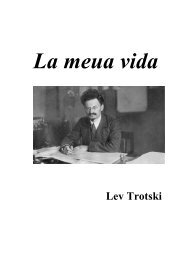epresented by the value <strong>of</strong> its product and labour time by the magnitude <strong>of</strong> that value. Theseformulæ, which bear it stamped upon them in unmistakable letters that they belong to a state <strong>of</strong>society, in which the process <strong>of</strong> production has the mastery over man, instead <strong>of</strong> beingcontrolled by him, such formulæ appear to the bourgeois intellect to be as much a self-evidentnecessity imposed by Nature as productive labour itself. Hence forms <strong>of</strong> social production thatpreceded the bourgeois form, are treated by the bourgeoisie in much the same way as theFathers <strong>of</strong> the Church treated pre-Christian religions.To what extent some economists are misled by the Fetishism inherent in commodities, or by theobjective appearance <strong>of</strong> the social characteristics <strong>of</strong> labour, is shown, amongst other ways, bythe dull and tedious quarrel over the part played by Nature in the formation <strong>of</strong> exchange value.Since exchange value is a definite social manner <strong>of</strong> expressing the amount <strong>of</strong> labour bestowedupon an object, Nature has no more to do with it, than it has in fixing the course <strong>of</strong> exchange.The mode <strong>of</strong> production in which the product takes the form <strong>of</strong> a commodity, or is produceddirectly for exchange, is the most general and most embryonic form <strong>of</strong> bourgeois production. Ittherefore makes its appearance at an early date in history, though not in the same predominatingand characteristic manner as now-a-days. Hence its Fetish character is comparatively easy to beseen through. But when we come to more concrete forms, even this appearance <strong>of</strong> simplicityvanishes. Whence arose the illusions <strong>of</strong> the monetary system? To it gold and silver, whenserving as money, did not represent a social relation between producers, but were natural objectswith strange social properties. And modern economy, which looks down with such disdain onthe monetary system, does not its superstition come out as clear as noon-day, whenever it treats<strong>of</strong> capital? How long is it since economy discarded the physiocratic illusion, that rents grow out<strong>of</strong> the soil and not out <strong>of</strong> society?But not to anticipate, we will content ourselves with yet another example relating to thecommodity form. Could commodities themselves speak, they would say: Our use value may bea thing that interests men. It is no part <strong>of</strong> us as objects. What, however, does belong to us asobjects, is our value. Our natural intercourse as commodities proves it. In the eyes <strong>of</strong> each otherwe are nothing but exchange values. Now listen how those commodities speak through themouth <strong>of</strong> the economist.“Value” – (i.e., exchange value) “is a property <strong>of</strong> things, riches” – (i.e., use value) “<strong>of</strong> man.Value, in this sense, necessarily implies exchanges, riches do not.” “Riches” (use value) “arethe attribute <strong>of</strong> men, value is the attribute <strong>of</strong> commodities. A man or a community is rich, a pearlor a diamond is valuable...” A pearl or a diamond is valuable as a pearl or a diamond.So far no chemist has ever discovered exchange value either in a pearl or a diamond. Theeconomic discoverers <strong>of</strong> this chemical element, who by-the-bye lay special claim to criticalacumen, find however that the use value <strong>of</strong> objects belongs to them independently <strong>of</strong> theirmaterial properties, while their value, on the other hand, forms a part <strong>of</strong> them as objects. Whatconfirms them in this view, is the peculiar circumstance that the use value <strong>of</strong> objects is realisedwithout exchange, by means <strong>of</strong> a direct relation between the objects and man, while, on theother hand, their value is realised only by exchange, that is, by means <strong>of</strong> a social process. Wh<strong>of</strong>ails here to call to mind our good friend, Dogberry, who informs neighbour Seacoal, that, “Tobe a well-favoured man is the gift <strong>of</strong> fortune; but reading and writing comes by Nature.”
Capital Vol. III. Chapter 2. The Rate <strong>of</strong> Pr<strong>of</strong>itThe general formula <strong>of</strong> capital is M-C-M’. In other words, a sum <strong>of</strong> value is thrown intocirculation to extract a larger sum out <strong>of</strong> it. The process which produces this larger sum iscapitalist production. The process that realises it is circulation <strong>of</strong> capital. The capitalist does notproduce a commodity for its own sake, nor for the sake <strong>of</strong> its use-value, or his personalconsumption. The product in which the capitalist is really interested is not the palpable productitself, but the excess value <strong>of</strong> the product over the value <strong>of</strong> the capital consumed by it. Thecapitalist advances the total capital without regard to the different roles played by itscomponents in the production <strong>of</strong> surplus-value. He advances all these components uniformly,not just to reproduce the advanced capital, but rather to produce value in excess <strong>of</strong> it. The onlyway in which he can convert the value <strong>of</strong> his advanced variable capital into a greater value is byexchanging it for living labour and exploiting living labour. But he cannot exploit this labourunless he makes a simultaneous advance <strong>of</strong> the conditions for performing this labour, namelymeans <strong>of</strong> labour and subjects <strong>of</strong> labour, machinery and raw materials, i.e., unless he converts acertain amount <strong>of</strong> value in his possession into the form <strong>of</strong> conditions <strong>of</strong> production; for he is acapitalist and can undertake the process <strong>of</strong> exploiting labour only because, being the owner <strong>of</strong>the conditions <strong>of</strong> labour, he confronts the labourer as the owner <strong>of</strong> only labour-power. Asalready shown in the first book, it is precisely the fact that non-workers own the means <strong>of</strong>production which turns labourers into wage-workers and non-workers into capitalists.The capitalist does not care whether it is considered that he advances constant capital to make apr<strong>of</strong>it out <strong>of</strong> his variable capital, or that he advances variable capital to enhance the value <strong>of</strong> theconstant capital; that he invests money in wages to raise the value <strong>of</strong> his machinery and rawmaterials, or that he invests money in machinery and raw materials to be able to exploit labour.Although it is only the variable portion <strong>of</strong> capital which creates surplus-value, it does so only ifthe other portions, the conditions <strong>of</strong> production, are likewise advanced. Seeing that the capitalistcan exploit labour only by advancing constant capital and that he can turn his constant capital togood account only by advancing variable capital, he lumps them all together in his imagination,and much more so since the actual rate <strong>of</strong> his gain is not determined by its proportion to thevariable, but to the total capital, not by the rate <strong>of</strong> surplus-value, but by the rate <strong>of</strong> pr<strong>of</strong>it. Andthe latter, as we shall see, may remain the same and yet express different rates <strong>of</strong> surplus-value.The costs <strong>of</strong> the product include all the elements <strong>of</strong> its value paid by the capitalist or for whichhe has thrown an equivalent into production. These costs must be made good to preserve thecapital or to reproduce it in its original magnitude.The value contained in a commodity is equal to the labour-time expended in its production, andthe sum <strong>of</strong> this labour consists <strong>of</strong> paid and unpaid portions. But for the capitalist the costs <strong>of</strong> thecommodity consist only <strong>of</strong> that portion <strong>of</strong> the labour materialised in it for which he has paid.The surplus-labour contained in the commodity costs the capitalist nothing, although, like thepaid portion, it costs the labourer his labour, and although it creates value and enters into thecommodity as a value-creating element quite like paid labour. The capitalist’s pr<strong>of</strong>it is derivedfrom the fact that he has something to sell for which he has paid nothing. The surplus-value, orpr<strong>of</strong>it, consists precisely in the excess value <strong>of</strong> a commodity over its cost-price, i.e., the excess<strong>of</strong> the total labour embodied in the commodity over the paid labour embodied in it. The surplusvalue,whatever its origin, is thus a surplus over the advanced total capital. The proportion <strong>of</strong>this surplus to the total capital is therefore expressed by the fraction s/C, in which C stands fortotal capital. We thus obtain the rate <strong>of</strong> pr<strong>of</strong>it s/C=s/(c+v), as distinct from the rate <strong>of</strong> surplusvalues/v.The rate <strong>of</strong> surplus-value measured against the variable capital is called rate <strong>of</strong> surplus-value.The rate <strong>of</strong> surplus-value measured against the total capital is called rate <strong>of</strong> pr<strong>of</strong>it. These are twodifferent measurements <strong>of</strong> the same entity, and owing to the difference <strong>of</strong> the two standards <strong>of</strong>measurement they express different proportions or relations <strong>of</strong> this entity.The transformation <strong>of</strong> surplus-value into pr<strong>of</strong>it must be deduced from the transformation <strong>of</strong> therate <strong>of</strong> surplus-value into the rate <strong>of</strong> pr<strong>of</strong>it, not vice versa. And in fact it was rate <strong>of</strong> pr<strong>of</strong>it which
- Page 4:
égime, which has been through its
- Page 7:
sins of all state forms. That this
- Page 13 and 14:
It has not occurred to any one of t
- Page 15 and 16:
gradually accumulated small capital
- Page 17 and 18:
from this nonsensical ‘prehistory
- Page 19 and 20:
property: the nucleus, the first fo
- Page 21 and 22:
which produces in all nations simul
- Page 23 and 24:
[8. The Inconsistency of the Ideali
- Page 25 and 26:
The ‘essence’ of the fish is it
- Page 27 and 28:
hence of the relationships which ma
- Page 29 and 30:
labour. In the first case, therefor
- Page 31 and 32:
production and commerce soon calls
- Page 33 and 34:
period begins with the Navigation L
- Page 35 and 36:
more advanced countries, still have
- Page 37 and 38:
over against the individuals, so th
- Page 39 and 40:
eality is only a product of the pre
- Page 41 and 42:
never became more than a city; its
- Page 43 and 44:
Only at this stage does self-activi
- Page 45 and 46:
Modern industry has established the
- Page 47 and 48:
these crises, there breaks out an e
- Page 49 and 50:
Further, as we have already seen, e
- Page 51 and 52:
abolish that; the development of in
- Page 53 and 54:
For the rest, nothing is more ridic
- Page 55 and 56:
III. Socialist and Communist Litera
- Page 57 and 58:
conscious of having overcome “Fre
- Page 59 and 60:
The undeveloped state of the class
- Page 61 and 62:
The Paris CommuneAddress to the Int
- Page 63 and 64:
priests were sent back to the reces
- Page 65 and 66:
pregnant. In the full consciousness
- Page 67 and 68:
subjected Versailles and the rest o
- Page 69 and 70:
The Eighteenth Brumaire of Louis Bo
- Page 71 and 72:
For the rest, every fair observer,
- Page 73 and 74:
that here “bourgeois republic”
- Page 75 and 76: Eternalization of historic relation
- Page 77 and 78: and becomes a direct object and ser
- Page 79 and 80: each supplies the other with its ob
- Page 81 and 82: generally. The question evidently b
- Page 83 and 84: is thus the only reality, the movem
- Page 85 and 86: smudge over all historical differen
- Page 87 and 88: elations. Thus e.g. the relation of
- Page 89 and 90: a rise of wages, because every reac
- Page 91 and 92: equally spent upon all articles of
- Page 93 and 94: Apart from some years of failing ha
- Page 95 and 96: enable a currency to adapt itself t
- Page 97 and 98: Smith and his French predecessors h
- Page 99 and 100: conditions of production, with a gi
- Page 101 and 102: in a commodity constitutes its valu
- Page 103 and 104: y working which the working man wou
- Page 105 and 106: just seen that the surplus value co
- Page 107 and 108: increased value of his labour, like
- Page 109 and 110: altogether, is sure to have his wag
- Page 111 and 112: theory, which consists in putting a
- Page 113 and 114: Preface to A Contribution to the Cr
- Page 115 and 116: Capital, Volume I (1867)From the Pr
- Page 117 and 118: A use value, or useful article, the
- Page 119 and 120: imposed necessity, without which th
- Page 121 and 122: embodiments of one identical social
- Page 123 and 124: abstract. The twofold social charac
- Page 125: ased on the production of commoditi
- Page 129 and 130: specific relationship to surplus-va


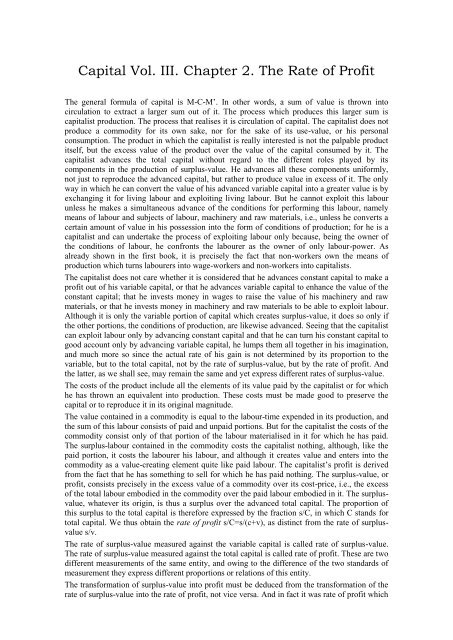
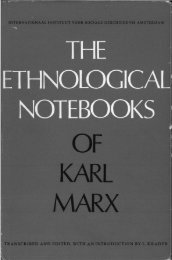

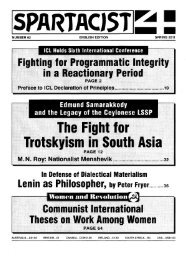

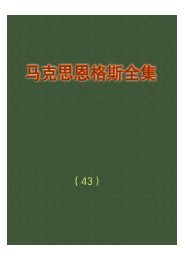
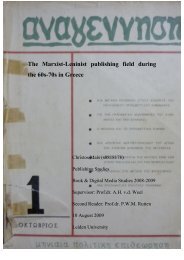
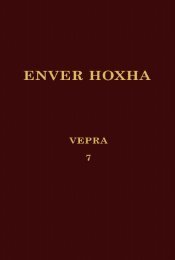
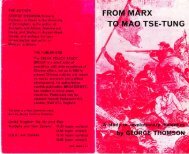

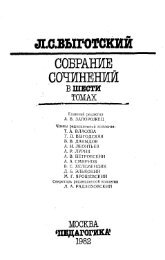
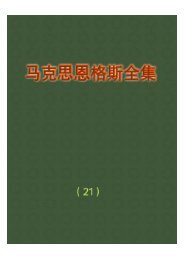
![tyf Enf=O=n]lgg](https://img.yumpu.com/47584932/1/190x245/tyf-enfonlgg.jpg?quality=85)
